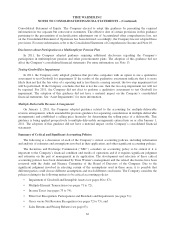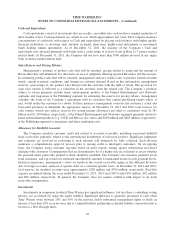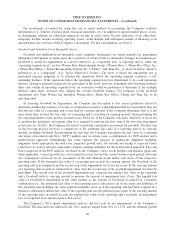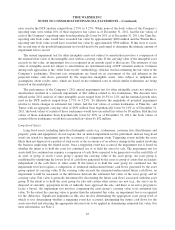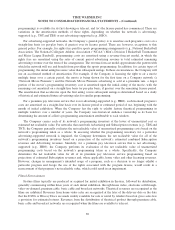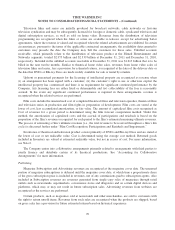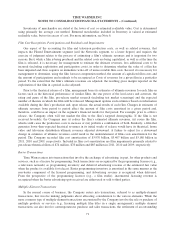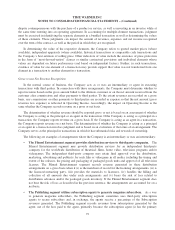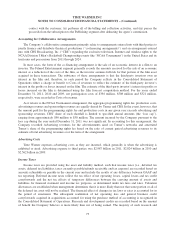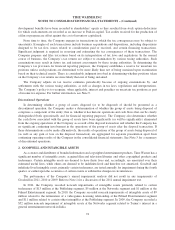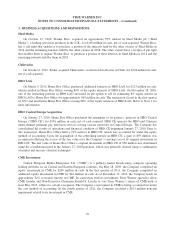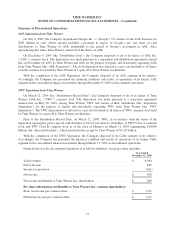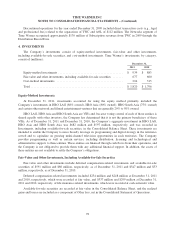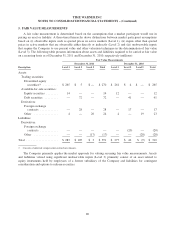Time Magazine 2011 Annual Report Download - page 86
Download and view the complete annual report
Please find page 86 of the 2011 Time Magazine annual report below. You can navigate through the pages in the report by either clicking on the pages listed below, or by using the keyword search tool below to find specific information within the annual report.TIME WARNER INC.
NOTES TO CONSOLIDATED FINANCIAL STATEMENTS – (Continued)
dispute contemporaneous with the purchase of a product or service, as well as investing in an investee while at
the same time entering into an operating agreement. In accounting for multiple-element transactions, judgment
must be exercised in identifying the separate elements in a bundled transaction as well as determining the values
of these elements. These judgments can impact the amount of revenues, expenses and net income recognized
over the term of the contract, as well as the period in which they are recognized.
In determining the value of the respective elements, the Company refers to quoted market prices (where
available), independent appraisals (where available), historical transactions or comparable cash transactions and
the Company’s best estimate of selling price. Other indicators of value include the existence of price protection
in the form of “most-favored-nation” clauses or similar contractual provisions and individual elements whose
values are dependent on future performance (and based on independent factors). Further, in such transactions,
evidence of value for one element of a transaction may provide support that value was not transferred from one
element in a transaction to another element in a transaction.
Gross versus Net Revenue Recognition
In the normal course of business, the Company acts as or uses an intermediary or agent in executing
transactions with third parties. In connection with these arrangements, the Company must determine whether to
report revenue based on the gross amount billed to the ultimate customer or on the net amount received from the
customer after commissions and other payments to third parties. To the extent revenues are recorded on a gross
basis, any commissions or other payments to third parties are recorded as expense so that the net amount (gross
revenues less expense) is reflected in Operating Income. Accordingly, the impact on Operating Income is the
same whether the Company records revenue on a gross or net basis.
The determination of whether revenue should be reported gross or net is based on an assessment of whether
the Company is acting as the principal or an agent in the transaction. If the Company is acting as a principal in a
transaction, the Company reports revenue on a gross basis. If the Company is acting as an agent in a transaction,
the Company reports revenue on a net basis. The determination of whether the Company is acting as a principal
or an agent in a transaction involves judgment and is based on an evaluation of the terms of an arrangement. The
Company serves as the principal in transactions in which it has substantial risks and rewards of ownership.
The following are examples of arrangements where the Company is an intermediary or uses an intermediary:
•The Filmed Entertainment segment provides distribution services to third-party companies. The
Filmed Entertainment segment may provide distribution services for an independent third-party
company for the worldwide distribution of theatrical films, home video, television programs and/or
videogames. The independent third-party company may retain final approval over the distribution,
marketing, advertising and publicity for each film or videogame in all media, including the timing and
extent of the releases, the pricing and packaging of packaged goods units and approval of all television
licenses. The Filmed Entertainment segment records revenue generated in these distribution
arrangements on a gross basis when it (i) is the merchant of record for the licensing arrangements, (ii) is
the licensor/contracting party, (iii) provides the materials to licensees, (iv) handles the billing and
collection of all amounts due under such arrangements and (v) bears the risk of loss related to
distribution advances and/or the packaged goods inventory. If the Filmed Entertainment segment does
not bear the risk of loss as described in the previous sentence, the arrangements are accounted for on a
net basis.
•The Publishing segment utilizes subscription agents to generate magazine subscribers. As a way
to generate magazine subscribers, the Publishing segment sometimes uses third-party subscription
agents to secure subscribers and, in exchange, the agents receive a percentage of the Subscription
revenues generated. The Publishing segment records revenues from subscriptions generated by the
agent, net of the fees paid to the agent, primarily because the subscription agent (i) has the primary
72


